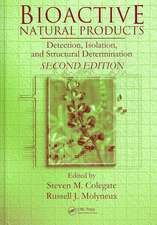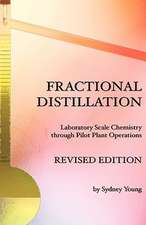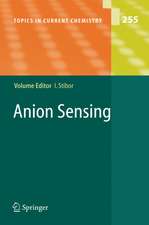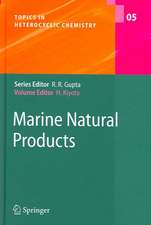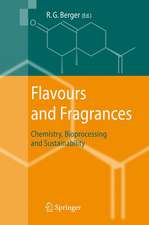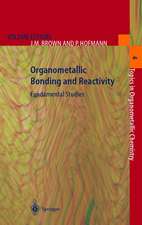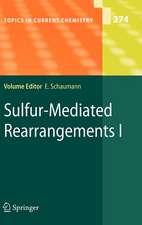New Frontiers in Organoselenium Compounds
Autor Eder João Lenardão, Claudio Santi, Luca Sancinetoen Limba Engleză Hardback – 14 iul 2018
This book will be of interest to specialists, students and researchers involved in a broad range of fields, from synthetic green chemistry to medicinal chemistry and the chemistry of natural products.
The connection between organoselenium compounds and green chemistry, despite having only recently emerged, is one of the subjects of this book. The first chapter highlights the use of Se-containing molecules as reagents and catalysts in new green protocols to access important organic transformations.
The book provides a wealth of examples of bioactive Se-containing molecules, especially focusing on those with potential therapeutic uses. The second chapter focuses on the state of the art concerning the role of organoselenium compounds as antioxidants, GPx mimics, and derivatives endowed with different bioactive properties. “Organoselenium in nature” is the title of the third chapter, which equips readers with essential information on the main natural organoselenium compounds and where they are found. Selected aspects of the metabolism of selenium in plants and microorganisms are also discussed. In closing, the book includes a chapter dedicated to recent advances concerning the nonbonding interactions between organochalcogen compounds. This is currently a hot topic in selenium chemistry and biochemistry, and here readers will find key insights into the chalcogen bond and its role in the biological activity of organoselenium compounds.
| Toate formatele și edițiile | Preț | Express |
|---|---|---|
| Paperback (1) | 692.09 lei 6-8 săpt. | |
| Springer International Publishing – 19 ian 2019 | 692.09 lei 6-8 săpt. | |
| Hardback (1) | 698.30 lei 6-8 săpt. | |
| Springer International Publishing – 14 iul 2018 | 698.30 lei 6-8 săpt. |
Preț: 698.30 lei
Preț vechi: 821.53 lei
-15% Nou
Puncte Express: 1047
Preț estimativ în valută:
133.62€ • 139.86$ • 111.21£
133.62€ • 139.86$ • 111.21£
Carte tipărită la comandă
Livrare economică 31 martie-14 aprilie
Preluare comenzi: 021 569.72.76
Specificații
ISBN-13: 9783319924045
ISBN-10: 3319924044
Pagini: 185
Ilustrații: VIII, 189 p. 187 illus., 39 illus. in color.
Dimensiuni: 155 x 235 mm
Greutate: 0.46 kg
Ediția:1st ed. 2018
Editura: Springer International Publishing
Colecția Springer
Locul publicării:Cham, Switzerland
ISBN-10: 3319924044
Pagini: 185
Ilustrații: VIII, 189 p. 187 illus., 39 illus. in color.
Dimensiuni: 155 x 235 mm
Greutate: 0.46 kg
Ediția:1st ed. 2018
Editura: Springer International Publishing
Colecția Springer
Locul publicării:Cham, Switzerland
Cuprins
Chapter 1.Organoselenium compounds as reagents and catalysts to develop new green protocols.- Chapter 2.Bioactive organoselenium compounds and therapeutic perspectives.- Chapter 3.Organoselenium in Nature.- Chapter 4.Nonbonded Interaction: the Chalcogen Bond.
Notă biografică
Eder J. Lenardão is a Full Professor in the Center of Chemical, Pharmaceutical and Food Sciences of the Federal University of Pelotas, Brazil. He received his BS from State University of Londrina (1991) and MS degree from Federal University of Santa Maria (UFSM) in 1994, under the supervision of Professor Claudio C. Silveira. In 1997, he earned a PhD degree in organic chemistry at University of São Paulo, under the supervision of Professor Miguel J. Dabdoub and in 2003 he worked with Professor Antonio L. Braga at UFSM as a postdoctoral fellow. Prof. Lenardão was a Visiting Professor at Perugia University (CAPES fellow) where he joined Prof. Claudio Santi’s group for one year (2015-2016). His research interest lies in the area of organic and green chemistry, developing new green protocols to prepare bioactive organochalcogen compounds.
Prof. Dr. Claudio Santi FRSC was awarded his PhD in 1996 under the supervision of Prof. Marcello Tiecco and in 1998 he received afellow of the Swiss National Foundation to spend a period as visiting Scientist in the “Institute für Organische Chemie” of Basel University. He has been invited as visiting professor in Jagiellonian University in Krakow (2007) School of Chemistry Cardiff University (2009) Jan Dlugosz University of Czestochowa (2013) and Universidade Federal de Pelotas (2014). In 2002 he became assistant professor and in 2005 aggregate professor at the Faculty of Pharmacy of the University of Perugia. Since October 2013 he is associated professor of Organic Chemistry at the Department of Pharmaceutical Sciences of the University of Perugia and in the 2013 he received the National Scientific Habilitation as Full Professor. Prof. Santi is a worldwide-recognized expert in organoselenium chemistry. He has pioneered the studies on the use of optically pure diselenides in asymmetric synthesis and it was the first to envision the possibility to use organoselenium reagents (with particular emphasis on catalysts) in Green Chemistry. Currently he is leading the international Network of research on Seleniun Sulfur and Redox Catalysis (SeSRedCat).
Prof. Dr. Luca Sancineto graduated in 2008 with a bachelor's degree in Pharmacy at the university of Perugia with a comprehensive final grade of summa cum laude. In 2012 he obtained his PhD degree in medicinal chemistry with a thesis focused on the design and synthesis of novel anti-HIV agents targeting the viral transcriptional machinery. In 2010 he was visiting researcher at the “International Centre for Genetic Engineering and Biotechnology (ICGEB)” of Trieste. From 2014 to 2017 he was a PostDoc in the group of Catalysis an Organic Green Chemistry of the Department of Pharmaceutical Sciences at the university of Perugia. In 2015 he guest-edited a special issue for Current Green Chemistry Journal focused on new green advances in organochalcogens chemistry. In 2017, he was granted with the an individual Marie Curie fellowship in the context of the Polonez 2 project from the Polish Academy of Sciences. Presently he is independent researcher at the Centre of Molecular and Macromolecular Studies, Polish Academy of Sciences in Lodz. His research interest lies in the development of new greener procedure for oxidation reactions and in the design and synthesis of selenium-containing compounds endowed with biological activities.
Prof. Dr. Claudio Santi FRSC was awarded his PhD in 1996 under the supervision of Prof. Marcello Tiecco and in 1998 he received afellow of the Swiss National Foundation to spend a period as visiting Scientist in the “Institute für Organische Chemie” of Basel University. He has been invited as visiting professor in Jagiellonian University in Krakow (2007) School of Chemistry Cardiff University (2009) Jan Dlugosz University of Czestochowa (2013) and Universidade Federal de Pelotas (2014). In 2002 he became assistant professor and in 2005 aggregate professor at the Faculty of Pharmacy of the University of Perugia. Since October 2013 he is associated professor of Organic Chemistry at the Department of Pharmaceutical Sciences of the University of Perugia and in the 2013 he received the National Scientific Habilitation as Full Professor. Prof. Santi is a worldwide-recognized expert in organoselenium chemistry. He has pioneered the studies on the use of optically pure diselenides in asymmetric synthesis and it was the first to envision the possibility to use organoselenium reagents (with particular emphasis on catalysts) in Green Chemistry. Currently he is leading the international Network of research on Seleniun Sulfur and Redox Catalysis (SeSRedCat).
Prof. Dr. Luca Sancineto graduated in 2008 with a bachelor's degree in Pharmacy at the university of Perugia with a comprehensive final grade of summa cum laude. In 2012 he obtained his PhD degree in medicinal chemistry with a thesis focused on the design and synthesis of novel anti-HIV agents targeting the viral transcriptional machinery. In 2010 he was visiting researcher at the “International Centre for Genetic Engineering and Biotechnology (ICGEB)” of Trieste. From 2014 to 2017 he was a PostDoc in the group of Catalysis an Organic Green Chemistry of the Department of Pharmaceutical Sciences at the university of Perugia. In 2015 he guest-edited a special issue for Current Green Chemistry Journal focused on new green advances in organochalcogens chemistry. In 2017, he was granted with the an individual Marie Curie fellowship in the context of the Polonez 2 project from the Polish Academy of Sciences. Presently he is independent researcher at the Centre of Molecular and Macromolecular Studies, Polish Academy of Sciences in Lodz. His research interest lies in the development of new greener procedure for oxidation reactions and in the design and synthesis of selenium-containing compounds endowed with biological activities.
Textul de pe ultima copertă
This book presents recent advances in and perspectives on the use of organoselenium compounds, primarily highlighting the new frontiers in the field of Green Chemistry, their therapeutic and biological relevance and new materials. Throughout its 200 pages, readers will find an updated and comprehensive review of new aspects of organoselenium chemistry and biochemistry. Fully referenced and written in an easy to read style, it offers readers a primary resource for including organoselenium derivatives in their projects.
This book will be of interest to specialists, students and researchers involved in a broad range of fields, from synthetic green chemistry to medicinal chemistry and the chemistry of natural products.
The connection between organoselenium compounds and green chemistry, despite having only recently emerged, is one of the subjects of this book. The first chapter highlights the use of Se-containing molecules as reagents and catalysts in new green protocols toaccess important organic transformations.
The book provides a wealth of examples of bioactive Se-containing molecules, especially focusing on those with potential therapeutic uses. The second chapter focuses on the state of the art concerning the role of organoselenium compounds as antioxidants, GPx mimics, and derivatives endowed with different bioactive properties. “Organoselenium in nature” is the title of the third chapter, which equips readers with essential information on the main natural organoselenium compounds and where they are found. Selected aspects of the metabolism of selenium in plants and microorganisms are also discussed. In closing, the book includes a chapter dedicated to recent advances concerning the nonbonding interactions between organochalcogen compounds. This is currently a hot topic in selenium chemistry and biochemistry, and here readers will find key insights into the chalcogen bond and its role in the biological activity of organoselenium compounds.
This book will be of interest to specialists, students and researchers involved in a broad range of fields, from synthetic green chemistry to medicinal chemistry and the chemistry of natural products.
The connection between organoselenium compounds and green chemistry, despite having only recently emerged, is one of the subjects of this book. The first chapter highlights the use of Se-containing molecules as reagents and catalysts in new green protocols toaccess important organic transformations.
The book provides a wealth of examples of bioactive Se-containing molecules, especially focusing on those with potential therapeutic uses. The second chapter focuses on the state of the art concerning the role of organoselenium compounds as antioxidants, GPx mimics, and derivatives endowed with different bioactive properties. “Organoselenium in nature” is the title of the third chapter, which equips readers with essential information on the main natural organoselenium compounds and where they are found. Selected aspects of the metabolism of selenium in plants and microorganisms are also discussed. In closing, the book includes a chapter dedicated to recent advances concerning the nonbonding interactions between organochalcogen compounds. This is currently a hot topic in selenium chemistry and biochemistry, and here readers will find key insights into the chalcogen bond and its role in the biological activity of organoselenium compounds.
Caracteristici
Brings to readers the state of the art of organoselenium compounds as reagents and catalysts, in particular for green chemistry Provides a comprehensive overview on bioactive organoselenium compounds and their potential therapeutic uses Introduces academic and industrial researchers into the realm of the natural occurring organoselenium compounds and their role in natural systems Collects the seminal and the more recent results which are contributing to the definition of chalcogen bonds

